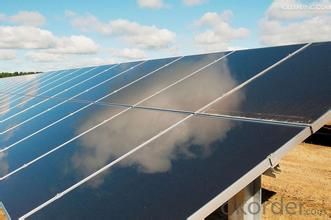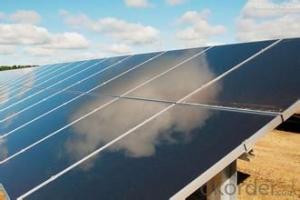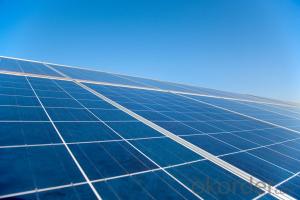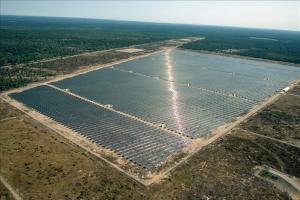250w 260w Monocrystalline Solar Panel Solar Module, TUV Certified
- Loading Port:
- Shanghai
- Payment Terms:
- TT or LC
- Min Order Qty:
- 100 watt
- Supply Capability:
- 111111 watt/month
OKorder Service Pledge
OKorder Financial Service
You Might Also Like
1.Structure of Solar Module Description
Solar panel refers either to a solar hot water panel, a common type of a solar thermal collector, or to one or more solar photovoltaics (PV) modules, electrically connected and mounted on a supporting structure.
A PV module is a packaged, connected assembly of typically 6×10 solar cells. Solar PV panels constitute the solar array of a photovoltaic systemthat generates and supplies solar electricity in commercial and residential applications. Each module is rated by its DC output power under standard test conditions, and typically ranges from 100 to 320 watts. The efficiency of a module determines the area of a module given the same rated output – an 8% efficient 230 watt module will have twice the area of a 16% efficient 230 watt module. There are a few solar panels available that are exceeding 19% efficiency. A single solar module can produce only a limited amount of power; most installations contain multiple modules. A photovoltaic system typically includes a panel or an array of solar modules, an inverter, and sometimes a battery and/or solar tracker and interconnection wiring.
2.Main Features of the Solar Module
1).High conversion efficiencies resulting in superior power output performance.
2).Outstanding power output even in low light or high temperature conditions
3).Optimized design for ease of soldering and lamination
4).Long-term stability,reliability and performance
3.Solar Module Images


4.Solar Module Specification
Specifications
Features:
Aesthetic appearance with excellent efficiency based on innovative
photovoltaic technologies
Strong frame, passing mechanical load test of 5400Pa, instead of the normal
2400Pa,to withstand heavier snow load and higher wind-pressure
Warranties:
10 years limited product warranty
15 years at 90% of the minimal rated power output
25 years at 80% of the minimal rated power output
Specificate sheet:
5.FAQ of Solar Module
1). Q: Are you a factory or trading company?
A: We are a factory.
2). Q: Where is your factory located? How can I visit there?
A: Our factory is located in Jiangyin, Jiangsu, China, near Shanghai. You are warmly welcomed to visit us!
3). Q: How can I get some samples?
A: Please connect me for samples
4). Q: Can the price be cheaper?
A: Of course, you will be offered a good discount for big amount.
- Q:Can solar panels be installed on a high-rise building?
- Yes, solar panels can be installed on a high-rise building. In fact, high-rise buildings offer great potential for solar panel installations due to their large surface area and access to sunlight. However, it is important to consider factors like structural integrity, shading, and local regulations while designing and installing solar panels on high-rise buildings.
- Q:I have this question for extracredit and I dont get it?How many 2V,2W PV panels would be required to supply a load that requires a 48-volt supply that can push at least 2.8 amps of current, if you assume each panel puts out A at 2 V? And how are the panels configured to supply the power requirements of the load?
- i agree with Liz but have a diffrent point i think u have not calculated for the roof mounted solar panels i am giving youy a bsic understanding hope that will help you Roof Mounted solar power systems consist of solar panels held in place by racks or frames which are attached to roof based mounting supports. Roof based mounting supports include: Pole mounts which are attached directly to the roof structure and may use additional rails for attaching the panel racking or frames. Ballasted footing mounts such as concrete or steel bases that use weight to secure the panel system in position and do not require through penetration. This mounting method allows for decommisison or relocation of solar panel systems with no impact on the roof structure.
- Q:Can solar panels be installed on a military base?
- Yes, solar panels can be installed on a military base. In fact, many military bases around the world have already implemented solar energy systems as part of their efforts to reduce dependence on fossil fuels and increase sustainability. Solar panels can be installed on rooftops, parking lots, or open grounds of military bases to generate clean renewable energy.
- Q:Do solar panels require a specific type of mounting system for installation?
- Yes, solar panels do require a specific type of mounting system for installation. The type of mounting system depends on various factors such as the location, roof type, and desired angle of the solar panels. Some common types of mounting systems include roof mounts, ground mounts, and pole mounts.
- Q:K i'm almost ready to give up! I've bought every kind of pv I can think of, and I can see this technology will not be affordable in my lifetime.I conserve all I can (so far as to handwashing my laundry etc) I'm not rich, but I'm saving for a solar pv with decent amperage. I love tinkering with things if I see the point.All the cells i've seen are very weak. What PV would you buy? (all I need is to power my computer from a deep cycle 2 volt battery connected to an inverter)God Bless You
- Solar okorder /
- Q:Since plants have been populating this earth for the past 475 million years I think they have evolved to gain the most sun with their greenery. If scientists used heat sensors to find the hot spots of trees and trim all of the leaves that don't quot;providefor the plant, then maybe that trimmed tree could be used to become a solar quot;panelquot;. I believe that each individual leaf could be replaced by a small solar panel and the wood of the tree would be wiring that would root all of the solar panels to a generator.
- solar panels do not use generators, but i like your idea, very creative.though i don't see the practicality of this being used commercially, i think it would make a great solar promotional piece though! off-subject, it is time we stop looking at the upfront costs of things and start looking at what the long term costs are. most green-technology, although expensive at first, end up saving tons of resources and actually increase profits of businesses! studies show that people who work in a green building tend to be happier which benefits health, more excited to go to work due to the business's environmental ethics, are more productive because of natural lighting, and are more efficient because more work is getting done. green buildings can actually boost the efficiency of a business! thus saving tons of money and reducing tons of waste. Doesn't this just make sense to you?
- Q:What is the purpose of solar panels?
- The purpose of solar panels is to convert sunlight into usable electricity, providing a renewable and sustainable source of power for various applications.
- Q:Can I use a regulator from a car to regulate the voltage from a solar panel to a battery?
- solar panels will naturally produce a certain DC voltage which is what your battery needs - the current will vary based on the sun light. You need probably 4V to have some over voltage. So based on your specs look at having at least 4 V but not too much over that (tells you how many panels you need in series) I would have blocking diodes (probably the solar cell has them built in) to insure the battery does not discharge thru the panel.
- Q:Hi! I bought a Coleman 2 vdc cooler that pulls 9 amps. What size solar panel and amp-hour battery do I need? I only open it 3 times a day. It will hold about 3 gals of milk.
- If it pulls 9 amps continuously, that's 08 watts/hour or about 2.5 kwh/day. If it only pulls half that (does it cycle?) it's about .2 kwh/day. You only want to drain a lead-acid battery 50% or so, so you'll want a 5 or 2.5 kwh battery pack. A typical setup for the 5 kwh would be two L-6 batteries in series, and for the 2.5 kwh you could use 2 T-05 batteries in series. This does not account for days of cloud. If you regularly have cloudy days, size the battery pack for two or three days of use with no input (2-3 x the sizes given above). To charge them, you typically want panels that will charge your battery at least 5% of its capacity per hour (C/20). For 2 volt nominal panels that's 0 amps for the T-05 or 20 amps for the L-6 batteries. It's good to have more than that for battery life (it cuts down on what's called stratification), so you'll want probably 50-200 watts of panels for the T-05 and 300-400 for the L-6. You'll also need a charge controller. Peltier coolers are very inefficient. You'll save money by using a regular mini-fridge and an inverter. Most mini-fridges only draw 50 watts or so, so you're talking 600 watt-hours for a 50% duty cycle. This means two T-05 batteries will give you two days of use and you'll only need 20-50 watts of panel. DK
- Q:When you get solar panels do you connect them to the grid?
- Sort of. They need to be connected to an inverter that changes the solar panel's DC electricity into AC electricity and it has to be synchronized with the phase of the power grid's AC. It must be done by a licensed electrician.
1. Manufacturer Overview |
|
|---|---|
| Location | |
| Year Established | |
| Annual Output Value | |
| Main Markets | |
| Company Certifications | |
2. Manufacturer Certificates |
|
|---|---|
| a) Certification Name | |
| Range | |
| Reference | |
| Validity Period | |
3. Manufacturer Capability |
|
|---|---|
| a)Trade Capacity | |
| Nearest Port | |
| Export Percentage | |
| No.of Employees in Trade Department | |
| Language Spoken: | |
| b)Factory Information | |
| Factory Size: | |
| No. of Production Lines | |
| Contract Manufacturing | |
| Product Price Range | |
Send your message to us
250w 260w Monocrystalline Solar Panel Solar Module, TUV Certified
- Loading Port:
- Shanghai
- Payment Terms:
- TT or LC
- Min Order Qty:
- 100 watt
- Supply Capability:
- 111111 watt/month
OKorder Service Pledge
OKorder Financial Service
Similar products
New products
Hot products
Hot Searches
Related keywords






























